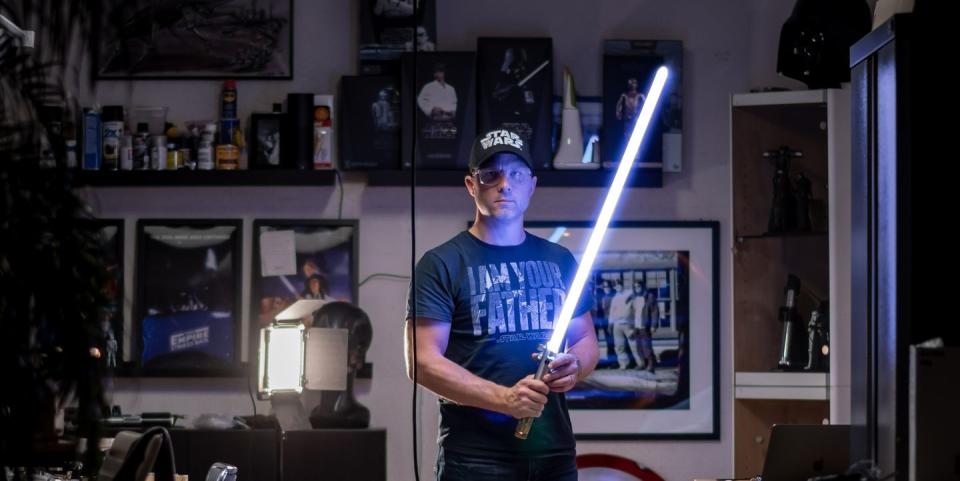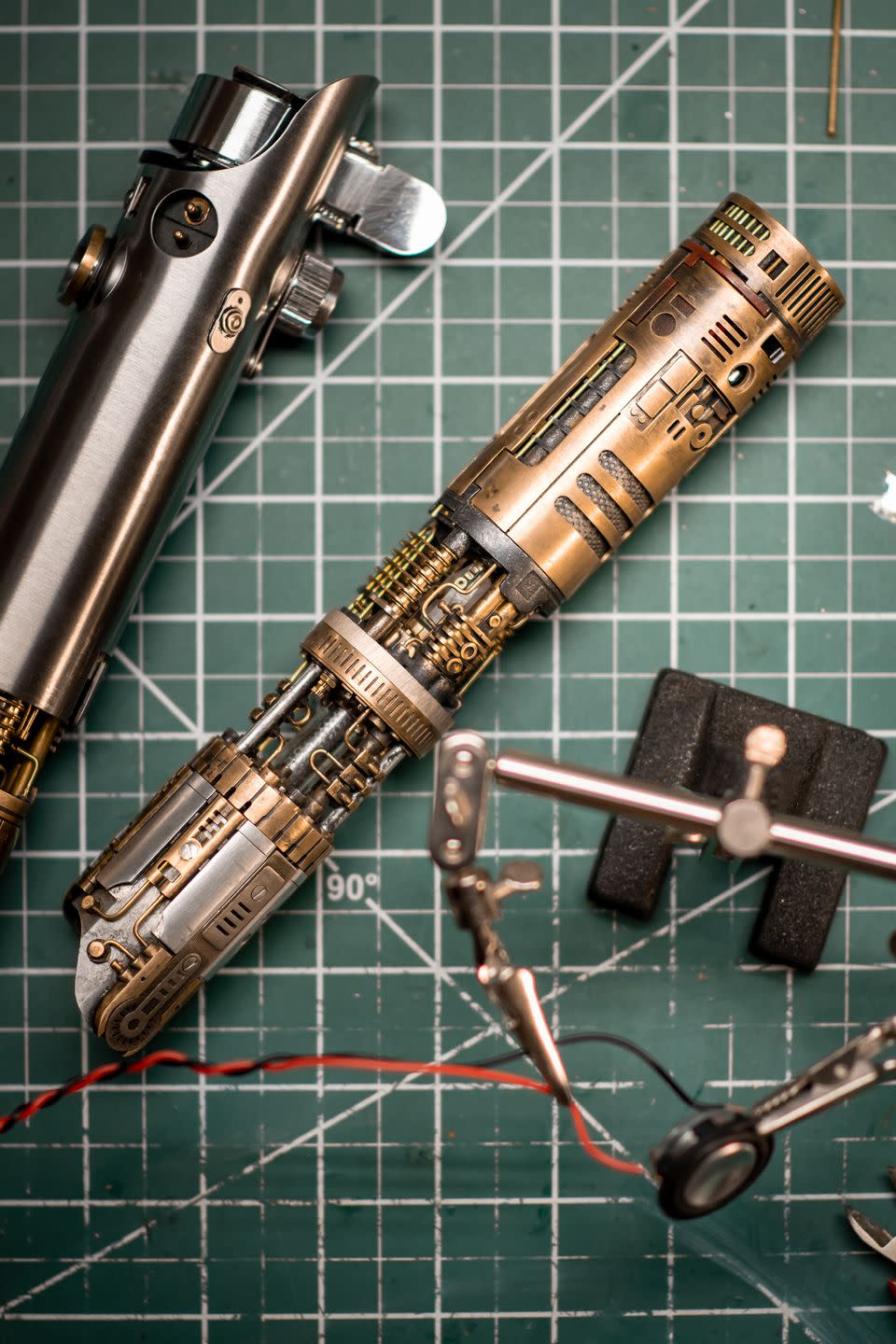This Volvo Designer Makes Star Wars Lightsabers in His Spare Time

There are millions of Star Wars fans around the world, but while many can do a fair impression of Yoda, far fewer can build his lightsaber. T. Jon Mayer is one of the few. By day, he leads a team of some 20 people as the head of Volvo's California design studio. In his spare time, he works from his home garage-turned-workshop, painstakingly hand-assembling vintage camera parts, tiny pieces of metal, and electronic components into high-end custom lightsabers more elaborate than anything seen on screen.
On a visit to Volvo's studio in Camarillo, California, Mayer leads us to an office where he's laid out dozens of parts and a handful of lightsabers in various stages of assembly. These aren't like anything you'd find in a toy store; they are handmade works of art. Sitting with them is Mayer's "lightsaber bible," cataloging every detail about each lightsaber from the films. He printed and bound it himself.

The world's first lightsaber was created for the original 1977 Star Wars film by set decorator Roger Christian and special effects guru John Stears. (Stears also outfitted James Bond's Aston Martin DB5 for Thunderball.) The hilt was fashioned from the handle of a 1940s Graflex camera flash, and the "blade" was made from a wooden dowel coated in retroreflective material, the same stuff that's used on reflective street signs. The lightsabers' colored glow was added in post production.
In the 1980s, Mayer was a kid a Philadelphia suburb where he drew cars, tinkered with and built stuff by hand, and replayed the original Star Wars films over and over. "It's all I watched," he recalls. After earning degrees in product design and transportation design, he worked for Ford for six years before moving to Volvo's main design studio in Gothenburg, Sweden. There, he helped transform the brand's lineup from boxy and boring to elegant and interesting. His credits include the Volvo Coupe and Estate concepts, as well as their respective production counterparts, the current-generation S60 and V60.
In January 2016, Mayer saw a YouTube video made by a fellow Star Wars fan. Martin Bayer built his own lightsaber, complete with sound effects and a glowing blade. "I did more research," Mayer says, "and ordered a kit to make my own within a month or two. The first one was fun. There was a learning curve with the electronics, but making things by hand was something I was very experienced with." He was hooked.
The following year, Mayer returned to Southern California to head Volvo's Camarillo design studio. There his interests not only grew, but they complemented each other. "I don't have to feel embarrassed that I bring lightsabers into work," he says. "We all have our passions here, whether that's music, dogs, or Star Wars." Mayer also says that George Lucas's straightforward approach to design and model making has inspired the way he leads his team. "The X-wing was literally an X. The Death Star was a circle inside a circle. We reference that iconic look every single day. I ask the designers, 'What's your theme? Can you really break it down?'"
And yes, there are a few Star Wars Easter eggs hidden in Mayer's work. Take a closer look at the front ends of the S60 and V60. "There might be some Darth Vader in there," he says.

"What I appreciate about the original sabers," Mayer says, showing off a vintage Graflex handle, "is that they're all made with found objects. They just used what they could get ahold of." Mayer's lightsabers, on the other hand, are primarily made from purpose-made parts. Some lightsabers use authentic Graflex handles, and others are made with replicas. The blades are polycarbonate tubes with LED light strips inside. Many of the detail pieces are 3D-printed and can be purchased online in DIY kits. Not all parts are off the shelf, however. Mayer has used brass rods, parts from model boat kits, and even speaker mesh that he's cut up and bent to fit. He assembles everything by hand, and each model takes about 30 hours to complete.
While the exteriors are often replicas of weapons shown in the movies (the look and color of each lightsaber varies from film to film and character to character), high-end lightsabers like the ones Mayer builds have a complicated inner workings, which slide out from the outer hilt and consists of about 40 parts. "The insides were never shown on film, so the chassis is an artistic interpretation," he says. Mayer's first lightsabers were made of plastic, which he painted and weathered to look like metal. Later he upgraded to real metals—typically brass or steel—which is he says are more interesting to work with.

Mayer further customizes his lightsabers with sound effects, colors, and lighting patterns, which he downloads from open-source websites and encodes onto a circuit board installed in each lightsaber's core. "I solder each wire by hand," Mayer says. "The wires are very small gauge and have to fit through the little guide holes inside the chassis to make their way to components such as the speaker, battery, LEDs, and buttons." Finished lightsabers can play clips of dialogue or music from the films, which users can switch through with the push of a button. In the design studio, Mayer lights up a lightsaber modeled after one used by two main characters in The Force Awakens, which glows electric blue and emits a familiar hum. We fire up a second lightsaber and engage in faux battle, delighting in the authentic movie sound the blades make when they connect.
Mayer says advances in digital technology have changed the way that both lightsabers and cars are made. "Both rely heavily on 3D modeling, which is not something we talk about a lot in car design," Mayer says. "The Volvo S60 and V60 were done about 98 percent digitally. It's not something we do with every car, but in [those cases] we did it because of my digital background." Although clay modeling is still an important part of vehicle design (Volvo's main studio in Gothenburg mills full-sized clay models of each vehicle), Mayer's studio is completely digital. His team uses a variety of hardware and software—including virtual reality—to create cars and to interact with other Volvo designers around the world.

Currently Mayer is working on a model of the lightsaber used by Kylo Ren (the new trilogy's villain) and a version of Yoda's lightsaber, which is noticeably smaller than the others. Mayer has built about 25 lightsabers to date and has sold most of them. Prices can range from about $3000 to $5000 each, depending on the parts used and the complexity of the build. No two are the same.
Like many Star Wars fans, Mayer is looking forward to seeing The Rise of Skywalker, the latest installment in the saga that has spanned more than four decades. "I'm hoping for some answers in the trilogy," he says, "like who is Rey and what happened to Luke's hand?" And despite Mayer's zeal for digital technology, he also believes that sometimes there's no substitute for human craftsmanship. "I'm glad that the new trilogy went back to using actual models and sets. This is something that made the originals so engaging and real—and is where the prequels failed, in my opinion."
Mayer loves his hobby, but he has no plans to quit his day job. "I love being a car designer. It's all based around passion. It's super competitive, so if you're not passionate about it, then do something else." Meanwhile, the man who has stoked the fires of Volvo and Star Wars fans alike has no lightsaber to call his own. "I will some day, but I enjoy the creative build process sometimes more than the finished product."
You Might Also Like

 Yahoo Autos
Yahoo Autos 